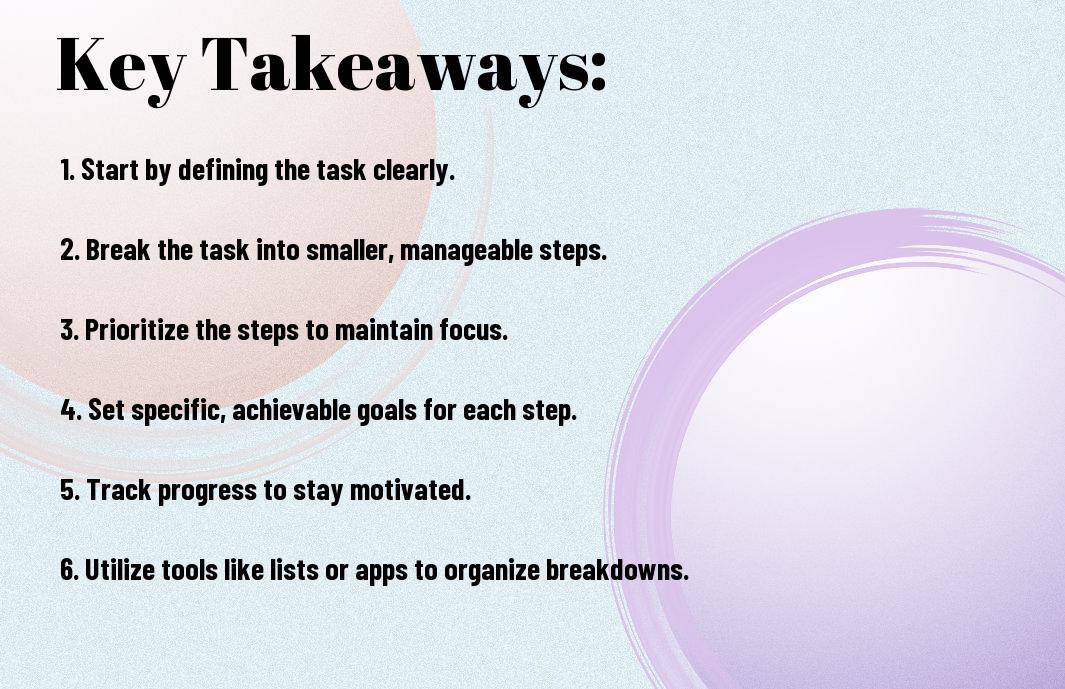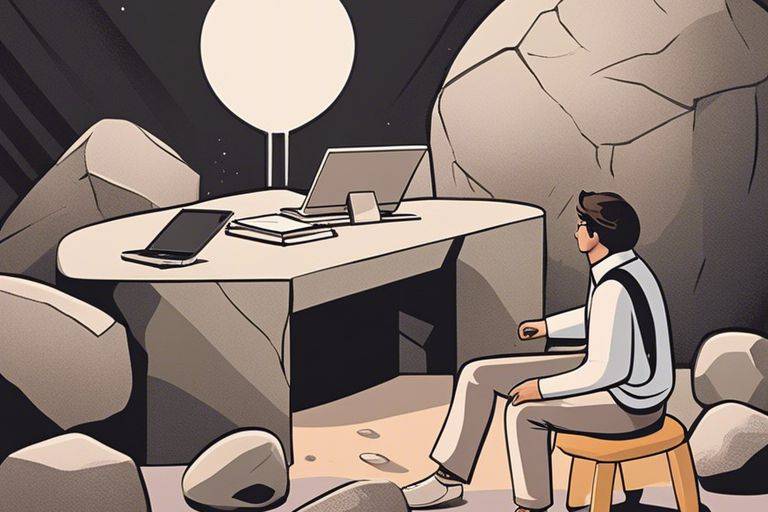
Newsletter Subscribe
Enter your email address below and subscribe to our newsletter

Enter your email address below and subscribe to our newsletter

The Breakdown Method is a powerful strategy for anyone feeling paralyzed by the enormity of a task or project. Breaking tasks down into smaller, more manageable steps can significantly reduce feelings of overwhelm and make it easier to take action. By breaking down a daunting task into smaller, more achievable goals, individuals can increase productivity and maintain a sense of control over their workload.


Now, when faced with overwhelming tasks or projects, it’s easy to feel paralyzed by the sheer magnitude of work ahead. This is where the Breakdown Method comes in – a proven strategy to tackle daunting tasks by breaking them down into smaller, more manageable components.
What is the origin of the Breakdown Method? While the concept of breaking down tasks into smaller steps can be traced back to various productivity and project management strategies, the Breakdown Method as we know it today has gained popularity in recent years due to its effectiveness in increasing productivity and reducing stress levels.
Concepts of the Breakdown Method revolve around the idea that by breaking down a large task into smaller, actionable steps, individuals can more easily navigate through complex projects and make progress towards their goals. The key to the Breakdown Method lies in creating a clear roadmap that outlines each step of the process, from start to finish.
To dive deeper into the Definition and Key Concepts of the Breakdown Method, it’s imperative to understand that the smaller the steps, the easier it is to stay focused and motivated throughout the project. By eliminating ambiguity and providing a structured approach to tackling tasks, individuals are better equipped to overcome obstacles and reach successful outcomes.
To tackle overwhelming tasks effectively, the Breakdown Method is a powerful strategy. By breaking down a large task into smaller, more manageable parts, individuals can approach each component with a clear focus and sense of direction. This method allows for a step-by-step approach that reduces the feeling of being overwhelmed, making the task seem more achievable.
Concentration plays a vital role in productivity, and the Breakdown Method can significantly enhance focus. When individuals break a task down into smaller parts, they can concentrate on one specific aspect at a time without distractions. This focused approach helps individuals stay on track and maintain concentration throughout the entire process.
Manageability: By breaking tasks down into smaller, actionable steps, individuals can stay organized and maintain a sense of control over their workload. This approach helps prevent feeling scatterbrained or unsure of where to begin.
An organized approach to tasks leads to improved productivity overall. When individuals have a clear breakdown of what needs to be done and when, they can work more efficiently and effectively. By focusing on completing one small task at a time, individuals can build momentum and stay motivated to continue working towards their goal.
Plus: Improved productivity not only helps individuals accomplish tasks more efficiently but also allows for more time to focus on other important responsibilities or enjoy leisure activities. This can lead to a better work-life balance and overall well-being.
The Breakdown Method can also help reduce stress levels associated with overwhelming tasks. Breaking a large task into smaller, manageable parts can make the overall workload feel less daunting. This approach can help individuals feel more in control and less overwhelmed, ultimately reducing stress levels.
Stress: By breaking tasks down, individuals can avoid the feeling of being buried under a mountain of work. This can lead to a more positive mindset and a healthier approach to tackling challenges.

Despite the initial sense of being swamped by a big task, the first step in applying the Breakdown Method is to identify what is overwhelming you. Take a moment to really pinpoint the root of your feelings of being overwhelmed. Is it the size of the project, the complexity of the task, or the amount of work involved? By understanding what specifically is causing this feeling, you can better address it.
With a clear understanding of the overwhelming task, the next step is to break it down into smaller, manageable goals. These goals should be specific, measurable, achievable, relevant, and time-bound (SMART goals). By setting SMART goals, you are turning the daunting task into a series of achievable milestones.
Setting measurable goals is important as it allows you to track your progress and stay motivated. When you can see the measurable outcomes of your efforts, it becomes easier to stay focused and keep moving forward.
To create a detailed breakdown plan, start by listing out all the sub-tasks required to complete the overwhelming task. Organize these sub-tasks in a logical order, identifying dependencies and prioritizing based on importance and urgency. Once you have a comprehensive breakdown plan, you can allocate timeframes and resources to each sub-task, giving you a clear roadmap to follow.
Planning with the Breakdown Method allows you to tackle even the most overwhelming tasks with confidence and efficiency. By breaking down the task, setting measurable goals, and creating a detailed plan, you can navigate through complexity and reach your desired outcome successfully.

Method: All overwhelming tasks can be conquered by breaking them down into smaller, manageable subtasks. Prioritizing these subtasks is crucial to ensure a smooth workflow. Begin by listing all the subtasks required to complete the task at hand. Once this list is compiled, identify the most important and time-sensitive subtasks that need immediate attention. By prioritizing subtasks based on their significance and deadlines, you can effectively allocate your time and resources to tackle them efficiently.
Management: All effective time management tools and techniques can enhance your productivity and help you stay organized while implementing the breakdown method. Utilize tools such as calendar apps, task management software, and time tracking tools to schedule your tasks, set deadlines, and monitor your progress. Techniques like the Pomodoro method, time blocking, and Eisenhower matrix can further optimize your time management skills.
Prioritizing: To prioritize your tasks effectively, consider using the ABCDE method, which categorizes tasks based on their urgency and importance. Assign letter grades to each task to determine which ones require immediate action and which ones can be postponed or delegated. By prioritizing tasks properly, you can focus your energy on high-priority items and avoid wasting time on less critical tasks.
One effective way to combat procrastination and distractions is to break down tasks into smaller, more manageable chunks. By breaking tasks into smaller subtasks, you can make progress without feeling overwhelmed. Additionally, eliminate distractions by creating a dedicated workspace, setting specific work hours, and using productivity tools to stay focused.
with: Do not forget, overcoming procrastination and distractions requires discipline and self-awareness. Identify your triggers and establish boundaries to prevent temptations from derailing your progress. Stay committed to your goals and remind yourself of the benefits of completing each task to stay motivated and on track.
Keep a close eye on your progress when breaking down overwhelming tasks. Tracking your advancements can help you stay focused and motivated throughout the process.
To effectively monitor your progress, consider using tools such as to-do lists, project management software, or even a simple pen and paper. Identify key milestones and deadlines to keep yourself on track. Regularly update your progress and make adjustments to your plan as needed.
Progress may not always go as planned, and that’s okay. When faced with unexpected challenges or delays, be prepared to adjust your plan accordingly. Reassess your timeline, resources, and priorities to ensure you can still meet your goals.
Monitoring your progress regularly allows you to catch any potential issues early on and make necessary changes to your plan. By staying proactive in tracking your advancements and adjusting as needed, you can overcome obstacles and reach your ultimate objective.
Monitoring progress isn’t just about keeping tabs on how far you’ve come; it’s also about celebrating the milestones you achieve along the way. Recognizing and rewarding yourself for completing smaller tasks can boost morale and drive your motivation towards reaching the finish line.
One key aspect of celebrating small wins is to acknowledge your accomplishments, no matter how minor they may seem. By taking the time to appreciate each step forward, you can maintain a positive mindset and build momentum to tackle the next phase of your task breakdown.
For those looking to enhance task management further, combining the Breakdown Method with Agile and Scrum methodologies can be a game-changer. Agile focuses on continuous improvement, flexibility, and collaboration within a team, whereas Scrum provides a framework for breaking tasks down into manageable chunks and setting clear goals. By integrating these methodologies with the Breakdown Method, individuals and teams can increase productivity, improve communication, and adapt to changing priorities more effectively.
Any individual seeking to maximize focus and productivity can benefit from incorporating the Pomodoro Technique with the Breakdown Method. This technique revolves around working in focused intervals (typically 25 minutes) followed by short breaks. By dividing tasks into smaller segments using the Breakdown Method and applying the Pomodoro Technique, individuals can maintain concentration, avoid burnout, and consistently make progress on tasks.
The Pomodoro Technique offers a structured approach to time management, ensuring individuals work efficiently while also taking necessary breaks to recharge. By combining this technique with the Breakdown Method, individuals can strike a balance between focused work and regular breaks, leading to sustained productivity and enhanced task completion.
With the Breakdown Method, utilizing Mind Mapping can provide a visual representation of tasks, ideas, and their relationships. Mind Mapping involves creating diagrams to connect information around a central concept, aiding in brainstorming, organization, and problem-solving. Integrating Mind Mapping with the Breakdown Method allows individuals to enhance their planning process, cultivate creativity, and gain clarity on the steps needed to accomplish a task.
Understanding how Mind Mapping complements the Breakdown Method can lead to improved organization, creativity, and problem-solving skills. By visually representing tasks and breaking them down into smaller components, individuals can streamline their workflow, foster innovative thinking, and map out a clear path to task completion.
For individuals utilizing the breakdown method, there are common pitfalls that can hinder progress. An important pitfall to watch for is becoming stuck in the planning phase. While breaking down tasks is important, spending too much time creating elaborate plans can become a form of procrastination. To avoid this pitfall, set a time limit for planning and focus on taking action.
Another challenge is losing sight of the bigger picture. Sometimes, when breaking down tasks into smaller steps, individuals may forget how these steps contribute to the overall goal. It’s crucial to periodically reassess progress and ensure that each small task is aligned with the ultimate objective.
Avoiding burnout is a crucial aspect of staying motivated while using the breakdown method. It’s important to prioritize self-care and take breaks when needed to prevent exhaustion. Setting realistic goals and celebrating small victories along the way can also help maintain motivation and keep momentum high.
It’s important to acknowledge the progress made after completing each small task. This not only provides a sense of accomplishment but also serves as a reminder of the steps taken towards achieving the end goal. By acknowledging progress, individuals can stay motivated and focused on the task at hand.
Following this breakdown method when faced with overwhelming tasks can help you better manage your time and resources. By breaking down a large project into smaller, manageable tasks, you can approach the work systematically and make steady progress towards your goal. This approach can also help reduce feelings of overwhelm and anxiety, allowing you to focus on completing one task at a time.
If you want to learn more about tackling overwhelming projects, you can check out this article on How To Tackle Large, Overwhelming Projects At Home Or Work for additional tips and strategies. Be mindful of, breaking down tasks into smaller steps can make even the most daunting projects more manageable and achievable.
A: The breakdown method is a strategy used to tackle overwhelming tasks by breaking them down into smaller, more manageable steps.
A: Using the breakdown method can help prevent feelings of being overwhelmed, increase productivity, and make complex tasks easier to accomplish.
A: To start using the breakdown method, begin by identifying the main task or goal that you want to achieve. Then, break it down into smaller, actionable steps.
A: The benefits of using the breakdown method include reducing stress, gaining clarity on what needs to be done, staying focused, and making progress towards your goals.
A: Yes, the breakdown method can be applied to tasks of any size or complexity, whether it’s a work project, personal goal, or household chore.
A: To stay organized when using the breakdown method, consider creating a checklist or timeline to track your progress, prioritize tasks, and ensure nothing gets overlooked.
A: Some tips to improve the effectiveness of the breakdown method include setting realistic deadlines for each step, focusing on one task at a time, and celebrating small victories along the way.
80/20 Rule (Pareto Principle) – Vilfredo Pareto’s Technique to Focus on High-Yield Tasks
Flow State – Mihaly Csikszentmihalyi’s Method to Achieve Optimal Focus and Enjoyment
Eisenhower Matrix – Dwight D. Eisenhower’s Strategy to Prioritize Tasks by Urgency and Importance
Deep Work – Cal Newport’s Secrets to Maximizing Focus on Demanding Tasks
Biological Prime Time – Scheduling Tasks When Energy Is Highest for Peak Productivity